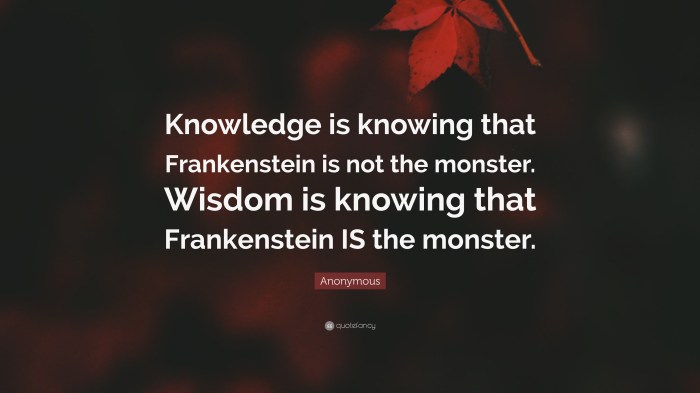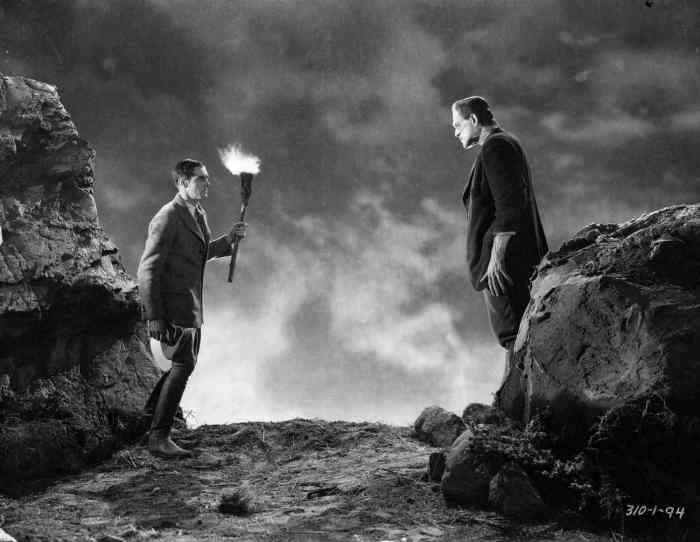Knowledge is knowing Frankenstein isn’t the monster. This common misconception has pervaded popular culture, obscuring the true nature of Mary Shelley’s iconic novel. In this essay, we will explore the origins of this misconception, examine the true identity of Frankenstein, analyze the monster’s perspective, and delve into the novel’s enduring themes and cultural impact.
Frankenstein, the novel, tells the story of Victor Frankenstein, a brilliant scientist who creates a creature from body parts. The creature, often erroneously referred to as “Frankenstein,” is abandoned by its creator and left to fend for itself in a hostile world.
The novel explores the ethical implications of scientific hubris, the search for identity and acceptance, and the consequences of isolation and prejudice.
Understanding the Misconception

The novel Frankensteinby Mary Shelley has been widely misunderstood, with the monster often mistaken for the creator. This misconception has persisted in popular culture, leading to confusion about the novel’s true nature and themes.
The origin of this misconception lies in the novel’s title, which refers to Victor Frankenstein, the scientist who creates the monster. However, the novel’s subtitle, “The Modern Prometheus,” suggests that the monster is the true protagonist, as he represents the dangers of scientific hubris and the consequences of creating life without considering its ethical implications.
The True Nature of Frankenstein
Victor Frankenstein is a brilliant scientist who is driven by his desire to create life. He succeeds in creating a living creature, but the monster he creates is deformed and rejected by society. This rejection leads the monster to seek revenge on Frankenstein and his family.
The novel explores the ethical implications of Frankenstein’s creation. Frankenstein creates the monster without considering the consequences of his actions. He is driven by his own ambition and does not take into account the monster’s feelings or needs. As a result, the monster becomes a symbol of the dangers of scientific hubris.
The Monster’s Perspective
The monster is a complex and tragic figure. He is rejected by society because of his appearance, and he is unable to find acceptance or love. As a result, he becomes isolated and angry. He seeks revenge on Frankenstein and his family, but he is ultimately defeated.
The novel explores the monster’s search for identity and acceptance. The monster is a creature without a name or a place in society. He is constantly searching for a sense of belonging, but he is always rejected. As a result, he becomes a symbol of the outcast and the marginalized.
The Themes of the Novel

Frankensteinexplores a number of important themes, including isolation, prejudice, and the consequences of scientific hubris. The novel shows how isolation can lead to anger and violence. It also shows how prejudice can lead to discrimination and hatred. Finally, the novel shows how scientific hubris can lead to disaster.
These themes are still relevant to contemporary society. Isolation, prejudice, and scientific hubris are all problems that we face today. Frankensteinis a cautionary tale that reminds us of the dangers of these problems and the importance of compassion and understanding.
Cultural Impact and Adaptations
Frankensteinhas had a profound impact on popular culture. The novel has been adapted into numerous films, television shows, and stage productions. It has also inspired countless works of art and literature.
Different adaptations of the novel have interpreted the story in different ways. Some adaptations have focused on the horror elements of the story, while others have focused on the novel’s themes of isolation and prejudice. However, all adaptations of the novel have captured the power and imagination of audiences around the world.
Symbolism and Allegory: Knowledge Is Knowing Frankenstein Isn’t The Monster

Frankensteinis a novel that is rich in symbolism and allegory. The monster can be seen as a symbol of the outcast and the marginalized. He can also be seen as a symbol of the dangers of scientific hubris.
The novel also contains a number of allegorical elements. The creation of the monster can be seen as an allegory for the dangers of industrialization. The monster’s rejection by society can be seen as an allegory for the discrimination and prejudice that marginalized groups face.
Historical and Scientific Context
Frankensteinwas written in 1818, during a time of great scientific and technological change. The novel reflects the anxieties and fears of the time. It also reflects the growing interest in science and the desire to understand the natural world.
Mary Shelley was influenced by a number of scientific advancements and philosophical ideas. She was particularly interested in the work of Erasmus Darwin, who argued that all living things evolved from a common ancestor. She was also influenced by the work of William Godwin, who believed that human beings are naturally good and that society corrupts them.
FAQ Summary
Who is the real monster in Frankenstein?
Victor Frankenstein, the scientist who creates the creature.
What is the main theme of Frankenstein?
The consequences of scientific hubris, the search for identity and acceptance, and the dangers of isolation and prejudice.
Why is Frankenstein still relevant today?
It explores timeless themes that resonate with contemporary society, such as the ethics of scientific advancement, the nature of identity, and the dangers of prejudice.